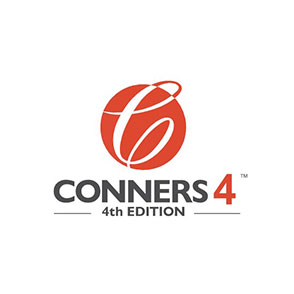Overdiagnoses of ADHD in children has been a great concern for Dr Conners. The prevalence of ADHD in youth is between five and eight percent, but nearly 25% of school-age children are medicated or prescribed medication for ADHD. Dr Conners hoped the improvement to his scales in the Conners 4 could help mitigate potential overdiagnoses. The Conners 4th Edition is the highly anticipated revision of the Conners 3rd Edition, the world’s leading Attention-Deficit/Hyperactivity Disorder (ADHD) assessment.
In addition to fairness and inclusivity principles, the Conners 4 contains a wealth of new research and data on ADHD and comorbid conditions that were incorporated into the conceptualisation and design of the test. Increased fairness and inclusivity include gender-inclusive language, culturally sensitive items, and items and scales that show no evidence of measurement bias concerning gender, race/ethnicity, country of residence, or parental education level.
The Conners 4’s accuracy has been increased by:
Providing a more comprehensive picture of how a rater approaches completing the measure using the Response Style Analysis that includes new and updated validity scales, the number of omitted items, and the average number of items completed per minute (pace).
Addressing critical concerns with Severe Conduct and Self-harm Critical Items and a Sleep Problems Indicator.
Measuring impairments related to ADHD symptoms in the school, social, and family domains.
Evaluating new content areas and common co-occurring problems such as Emotional Dysregulation, Depressed Mood, and Anxious Thoughts.
Applying a dimensional approach to ADHD assessment with an additional DSM Symptoms Scale; Total ADHD Symptoms.
The Conners 4 is now fully digital to help you save time and improve efficiency with customisable reports, a complimentary digital manual, online scoring and reporting, and printable forms. The Conners 4 offers online scoring only. Scoring online is less prone to errors than hand scoring and takes very little time. While hand scoring will not be available, paper administration will still be possible by printing a paper form from MHS Online Assessment Center+. The responses from the paper form can then be entered for online scoring and report generation on your MHS Online Assessment Center+ portal.
ASSESSMENT SCALES
The Conners 4 contains the following scales:
Content Scales
Inattention/Executive Dysfunction: Reflects issues the youth may have with focussing, sustaining, and shifting attention, as well as self-image.
Hyperactivity: Reflects the youth’s level of motor or verbal activity and restlessness.
Impulsivity: Reflects difficulties a youth may have with response inhibition.
Emotional Dysregulation: Reflects the youth’s experience of, or difficulty with, regulating or managing emotions.
Depressed Mood: Reflects features of depression.
Anxious Thoughts: Reflects the youth’s experience of and difficulty with, regulating fears and worries.
DSM Symptom Scales
ADHD Inattentive Symptoms: Reflects each of the DSM Symptom Scales Diagnostic Criteria A for ADHD Predominantly Inattentive Presentation.
ADHD Hyperactive/Impulsive Symptoms: Reflects each of the DSM Symptom Scales Diagnostic Criteria A for ADHD Predominantly Hyperactive/Impulsive Presentation.
Total ADHD Symptoms: Provides a dimensional representation of the ADHD symptoms, irrespective of presentation type.
Oppositional Defiant Disorder Symptoms: Reflects each of the DSM Symptom Scales Diagnostic Criteria A for Oppositional Defiant Disorder.
Conduct Disorder Symptoms: Reflects each of the DSM Symptom Scales Diagnostic Criteria A for Conduct Disorder.
Response Style Analysis
Negative Impression Index: Flags potential symptom exaggeration.
Inconsistency Index: Flags possible random or careless responding.
Omitted Items: Provides a count of the number of omitted items and its impact on the scores.
Pace: Flags for unusual administration response rates.
Critical Indicator Items
Severe Conduct Critical Items: Reflects severe misconduct and behaviours that describe past violence, destructive behaviours, or harm to others.
Self-Harm Critical Items: Reflects past suicidal thoughts or attempts and self-injurious behaviours.
Sleep Problems Indicator: Reflects behaviours that may suggest problems or difficulties with sleep.
Impairment and Functioning Outcome Scales
Schoolwork: Reflects typical problems or difficulties that youth with ADHD experience in their schoolwork.
Peer Interaction: Reflects typical problems or difficulties that youth with ADHD experience when interacting with peers.
Family Life: Reflects typical problems or difficulties that youth with ADHD experience or contribute to in family interactions.
Conners 4 ADHD Index
Conners 4 ADHD Index: 12-item index selected from the Conners 4 that best distinguishes youth with a diagnosis of ADHD from youth in the general population.
Additional Questions (open-ended)
Impact of Symptoms in Functional Domains: Ask about the pervasiveness of the problems reported in the different domains of the functioning.
Other Concerns: Ask about other current issues or problems not reported in the Conners 4.
Strengths/Skills: Ask about the youth’s strengths and skills.
In addition to the full-length Conners 4 , there is also a Conners 4–Short, which is useful when a rater has limited time or when the rater will be asked to complete the Conners 4 repeatedly (e.g., monthly assessment of treatment response). This form takes less time to complete than the full-length form but is not as comprehensive because it has fewer scales and fewer items per scale (for both Content and Impairment and Functional Outcome scales).
AREAS OF APPLICATION
The Conners 4 is invaluable when making decisions about clinical diagnoses and educational eligibility during intervention planning and monitoring, in research contexts, and for screening purposes.
REPORT OPTIONS
The Conners 4 has the following report available:
Single Rater Report: Provides detailed information about scores from a single administration, presented numerically, graphically, and within an interpretive summary. A youth’s scores are compared to those in one or more Normative Samples, and optionally, to an ADHD Reference Sample. Also includes a Within-Profile Comparison of the youth’s results to their own average score. Elevations at both the scale and item level are included. Key results are provided in a one-page overview.
Multi-Rater Report: combines the results of up to five raters to provide an overview of the youth’s behaviour from a multi-rater perspective. It highlights potentially important inter-rater differences in scores. It is available for the full-length Conners 4, Conners 4–Short, and the Conners 4–ADHD Index.
Product Info
Training
Optional
Age range
6-18 years
Administration time
Conners 4: 15 minutes; Conners 4 Short: 5-7 minutes; Conners 4 ADHD Index: 1-2 minutes
Norms
Global
Languages
English
Administration Platform
Online
Integrated reports
None
Author
C. Keith Conners, (PhD)
Publisher
Multi-Health Systems Inc
Questions about Conners 4th Edition (Conners 4™)?
Ask an expert
Fill in the form and one of our product experts will be in touch with you.


